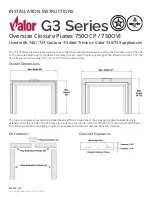
5
Installation and Operation
Installation Regulations
This gas appliance must be installed by a qualified installer in
accordance with local building codes, or in the absence of local
codes, with the current CAN/CGA-B149.1 or .2 Installation Code
(in Canada) or the current National Fuel Gas Code Z223.1 when
installed in the United States.
This appliance, when installed, must be electrically connected and
grounded in accordance with local codes, or in the absence of local
codes, with the current CSA C22.1 Canadian Electrical Code or
with the national Electrical Code; ANSI/NFPA 70-1987 when
installed in the United States.
FOR SAFE INSTALLATION AND OPERATION OF
YOUR GAS FIREPLACE PLEASE NOTE THE
FOLLOWING:
1.
This appliance gives off high temperatures and should be
located out of heavy traffic areas and away from furniture
and draperies.
2.
Children and adults should be alerted to the hazards of the
high surface temperatures of this appliance and should stay
away to avoid burns or ignition of clothing.
3.
Children should be carefully supervised when they are in
the same room as your fireplace appliance.
4.
Under no circumstances should this appliance be modified.
Any parts that have to be removed for servicing should be
replaced prior to operating this appliance.
5.
Installation and repair should be done by a qualified service
person. The appliance should be inspected before use and
at least annually by a professional service person. More
frequent cleaning may be required due to excessive lint
from carpeting, bedding material, et cetera. It is imperative
that control compartments, burners and circulating air pas-
sageways of the appliance be kept clean.
6.
Control compartments, burners and air passages in this
appliance should be kept clean and free of dust and lint.
Make sure that the gas valve and pilot light are turned off
before you attempt to clean this unit.
7.
The venting system (chimney) of this appliance should be
inspected at least once a year and if needed, your venting
system should be cleaned.
8.
Clothing or other flammable material should not be placed
on or near the appliance.
This appliance should not be used as a drying rack for
clothing nor should Christmas stockings or decorations be
hung from it.
9.
Under no circumstances should any solid fuels (wood, paper)
be used in this appliance.
10. For safe operation, glass doors must be closed.
11. Do not use this heater if any part has been under water.
Immediately call a qualified service technician to inspect the
heater and to replace any part of the control system and any gas
control which has been under water.
12.
WARNING: Do not operate appliance with the glass front
removed, cracked or broken. Replacement of glass should
be done by a licenced or qualified service person.
13. Do not operate appliance unless completely installed as per
installation instructions.
This gas appliance should be installed by a qualified installer in
accordance with local building codes and with current CAN/CGA -
B149 (.1 or .2) installation codes for Gas Burning Appliances and
Equipment.
Never use your gas fireplace as a cooking device.
The Burner/Log Assembly has been engineered and permanently
adjusted for proper flame control.
Periodically remove the logs from the grate assembly and vacuum
any loose particles from the grate and burner areas.
See log Placement on Pages 11-20 to remove logs, vacuum burner
parts and replace logs.
Note: It is normal for your gas fireplace to give off some odor
the first time it is burned. This is due to the curing of the paint
and any undetected oil from the manufacturing process.
Please ensure that your room is well ventilated - open all windows.
It is recommended that you burn your gas fireplace for at least four
(4) hours the first time you use it without the fan on.
Make adequate accessibility clearances for servicing and proper
operation.
This appliance must not be connected to a chimney flue serving a
separate solid fuel burning appliance.
Be sure that the flow of combustion and ventilation air is not
obstructed.
Warning:
When purging the gas line, the glass front must be
removed.
Do not alter gas orifice.
Vertical Venting in Cold Climates
In cold climate conditions where temperatures go below -10 degrees
Celsius or 14 degrees Fahrenheit, we recommend that the chase be insu-
lated and where the vent pipe enters into the attic space that the pipe be
wrapped with an insulated mylar sleeve. This will increase the tempera-
ture of the vent and help the appliance to vent properly in cold weather
conditions.
It is also important in vertical vented direct vent appliances that the appli-
ance be operated daily during the winter months as this will help stop the
Termination from freezing up. We recommend using a thermostat set at
room temperature to allow the unit to cycle.






































